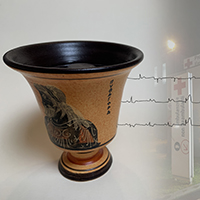A rare case of acute alcohol intoxication mimicking an electrocardiographic pattern for acute coronary syndrome with ST-segment elevation

Accepted: 20 December 2019
All claims expressed in this article are solely those of the authors and do not necessarily represent those of their affiliated organizations, or those of the publisher, the editors and the reviewers. Any product that may be evaluated in this article or claim that may be made by its manufacturer is not guaranteed or endorsed by the publisher.
Authors
A patient presenting an ST-segment elevation could represent a life-threatening condition in Emergency Department (ED). This case shows how sometimes, a chronic, and more often, an acute abuse of alcohol is related to important harmful effects on myocardial contractility. The authors present a case of a 19-year-old male of oriental-Asiatic origin admitted unconscious to ED with alcoholic fetor: on electrocardiogram a significant and widespread STsegment elevation was observed. A bedside echocardiography showed no abnormalities in segmental kinetics; therefore electrocardiogram- alterations could be related to a coronary spasm. The literature is poor about this effect induced by acute alcohol ingestion: the pathophysiological mechanism at the base of the abnormal muscle contractility, seems to be related to an impairment in cyclic guanosine monophosphate production, although a second and less probable hypothesis could be an altered intracellular concentration of calcium levels.
How to Cite
PAGEPress has chosen to apply the Creative Commons Attribution NonCommercial 4.0 International License (CC BY-NC 4.0) to all manuscripts to be published.

 https://doi.org/10.4081/ecj.2020.8596
https://doi.org/10.4081/ecj.2020.8596








